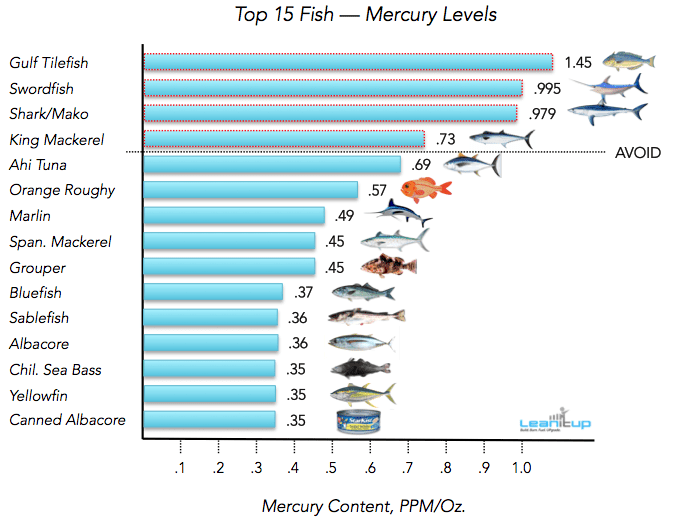The Mercury level in tuna has been a subject of debate for decades now. Paul Drevnick, Assistant Research Scientist at University of Michigan and his team analyzed data from over the past 50 years and found that mercury levels in Pacific yellowfin tuna, often marketed as ahi tuna, is increasing at 3.8% per year. If 3.8% per year doesn’t seem like much, that translates into a doubling at every 20 years. So in 50 years, mercury levels have increased 6 times.

Mercury is a neurotoxin – it can cause significant damage to nerve tissue. Mercury exists in a number of different compounds, though methylmercury (MeHg+), dimethylmercury and diethylmercury are the only significantly neurotoxic forms. Diethylmercury and dimethylmercury are considered some of the most potent neurotoxins ever discovered. Mercury levels in tuna are now approaching levels deemed unsafe for human consumption by the EPA.
The initial surprise was that high mercury levels were reached consistently throughout the globe, even in pristine areas in Scandinavia or North America. This happens because most of the mercury comes from coal plants; as the coal plants burn coal, mercury can easily travel throughout the globe (even several times) before settling down as dust or rain. As it settles down on water, it is then absorbed by fish. As Drevnik explains, many people have the wrong idea that the world’s ocean is simply too large to be polluted.
“Two manuscripts published in Science in the early 1970s supported this argument. The first stated that mercury pollution could only result in a negligible increase in mercury levels in open ocean water,” he writes.

But new research contradicts that idea. Namely, dillution is not a solution to pollution. Mercury is not something easily eliminated from the body, so if it gets absorbed by a plant or an animal, it pretty much travels throughout the food chain, so that top predators contain much more mercury. The study found that methylmercury levels in predatory fish are about a million times greater than in the water in which they swim. Furthermore, mercury levels continue to rise, at an average of 3.8% a year.
“The statistical comparison indicated mercury levels were higher in 2008 than in either 1971 or 1998. As a result, we concluded that mercury levels are increasing in yellowfin tuna near Hawaii. The rate of increase between 1998 and 2008 of 3.8% per year is equivalent to a modeled increase in mercury in ocean waters in the same location.”
The only question mark is now where the mercury is coming from – and the scientific evidence seems to indicate we are doing it. Coal plants are the main source of pollution, closely followed by cement kilns. Other sources are trash burning and gold mining. We need to find better ways to deal with our mercury pollution, and that’s exactly the aim of the new United Nations Environment Programme’s Minamata Convention on Mercury.
In the mean time, we also have to keep avoid eating too much tuna.






